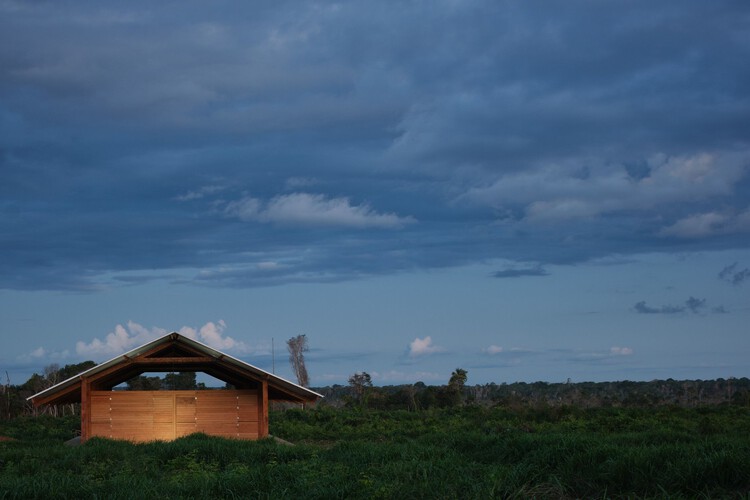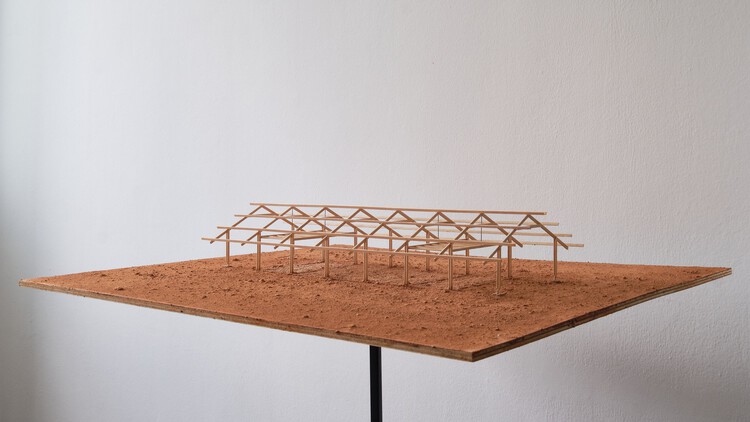
-
Architects: Estúdio Gustavo Utrabo
- Area: 368 m²
- Year: 2019

Context. The recent history of Brazil’s indigenous peoples and landscapes has been marked by violence. When the first European settlers arrived in 1500, what is now Brazil was inhabited by an estimated number of 11 million indigenous people in roughly 2,000 kindred settlements. After the first century of the invasion, 90% of that population had been wiped out, mainly by diseases such as flu, measles and smallpox, brought by the colonizers. In the following centuries, thousands more died in slavery. Today, Brazil’s indigenous cultures continue their daily struggle to stay alive and preserve their territories under to the current political and economic circumstances. Due to that, the project was settled, not only in a context of political struggle and resistance, but of a different way of relating with indigenous communities, since today’s villages and its inhabitants don’t match anymore with the old idyllic visions of modernity anymore. The architectural project proposes another way of seeing and relating to its landscape and territory, by supporting its concentric territorial configuration, establishing a distance, using local and industrial materials, revealing the passage of time and opening itself, by reclaiming a multipurpose support needed by the community. In response to the local context of this project, the first canopy for the Xingu Indigenous Park was built for the Kisêdjê Settlement, but other settlements will be able to embody its structure, which represents an important reclamation of the community’s rights and adaptation in an ever- changing culture.



Objectives. The project aims to establish a channel of exchange between different cultures and processes of building in the present. Regarding that, the intention is not to replicate the local culture but to encourage dialogue through differentiation. The project functions as a relative, or a distant neighbor, built as a modular system possible to be replicated, appropriated and changed according to each community in the Park. The constructive system conforms flexible and multipurpose spaces for the people through a locally-manufactured timber structure which can be easily assembled, enlarged, shrunk and displaced, bearing in mind the mobility of the indigenous peoples. The Canopy represents an important imaginary of this relation. It aims to hold the sky, to build a veranda and to embrace the people. Different from the closeness of the original ocas, the proposal opens to its surroundings through symmetry, alignment, scale, and the typology of the first shelters. The veranda, in this sense, is the device of the encounter between inside and outside. In the oca the shadow has weight – it encloses and protects its dwellers. Here, on the other sense, the shadow has another weight – it is possible to be inside and outside, to see and to be seen, to stay in and to be with someone on the outside. It is through seeing in the shadow that another relation between people and the environment is possible. In the Canopies for the Xingu villages, the shadow allows the veranda, which allows mediation, which allows another relation with the community and our forests.





Performance. The community’s displacement and the construction of the recent settlements was vital for maintaining the health of its inhabitants, who are fleeing the harmful effects caused by the indiscriminate use of pesticides in the soy plantations that surround the park. The engagement with the client - ISA (Socioambiental Institute) -, a Ngo compromised with social rights, indigenous rights and the environment, represents a key role and invisible part of the process by establishing the mediation needed to expand the architectural field through dialogue with the local community, its way of living and territory.

Based on discussions between architecture, local builders and ancestral knowledge, the Canopies for the Xingu Indigenous Park intend to relate with a culture without property and without owner, which developed its specific architectonic solutions, such as the assemblage of low maintenance elements, the use of raw materials, and by keeping a concentric space in its middle, to gather the community in collective activities. The walls and internal partitions were appropriated and transformed according to the residents needs and the uses of each village. Not only economical restrictions lead to a simpler architectonic solution, but also the limited relation with the site during its making. Explanatory models and drawings about the construction process were sent to the village to facilitate the execution process. Due to the success of the first canopy, other two structures were made for the surrounding communities of the Xingu Indigenous Park to contribute and strengthen the local culture.



























